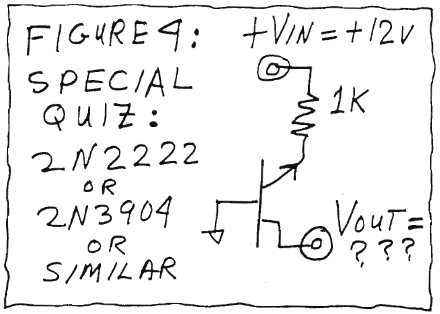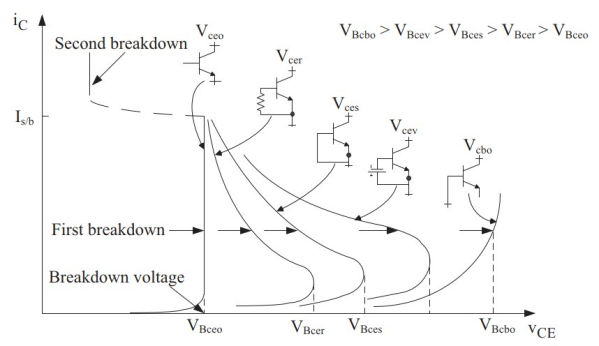We always enjoy [History Guy]’s musing on all things history, but we especially like it when his historical stories intersect with technology. A good example was his recent video about a small secret group during the Second World War that deployed to the European Theater of Operations, carrying out secret missions. How is that technology related? The group was largely made of scientists. In particular, the team of nineteen consisted of a geographer and an engineer. Many of the others were either fluent in some language or had been through “spy” training at the secret Military Intelligence Training Center at Camp Ritchie, Maryland. Their mission: survey Europe.
Science1249 Articles
2025 Component Abuse Challenge: Reverse Biasing An NPN BJT
For the Component Abuse Challenge our hacker [Tim Williams] observes that N-P-N reads the same way forwards and backwards, so… what happens if we reverse bias one? (Note: this remark about N-P-N reading the same forward and backward is a lighthearted joke; in fact the level of doping in the emitter and collector is different so those Ns are not fungible and will exhibit different properties and have different characteristics.)
 In the margin you can see how the question was originally posed by Bob Pease back in March 18, 1996.
In the margin you can see how the question was originally posed by Bob Pease back in March 18, 1996.
In his article [Tim] mentions that some transistors are specifically designed to operate when reverse biased, which [Tim] calls “inverted mode”, whereas most transistors are not designed to work in this fashion and that’s the sort of abuse that could damage the component and lead it to malfunction.
But what is Vout? [Tim] reports that he measured approximately -0.4 volts using his high-impedance meter. We tried this experiment in the lab ourselves but we were not able to duplicate [Tim]’s result; however there is a long list of potential reasons for such an outcome. If you do this experiment yourself we would love to hear about your results in the comments section!
If you’re still learning about transistors you might like to check out our five part series on transistors as amplifiers, starting here: Won’t Somebody, Please, Think Of The Transistors!
Thanks to [Tim] for his submission, we wish him the best of luck in the competition!
Medieval Iron, Survivorship Bias And Modern Metallurgy
When you hear it said that “Modern steel is disposable by design”, your ears perk up, as you just caught the unmistakable sound of faux romanticism along with ‘lost ancient technology‘ vibes. Although it happens sometimes that we did lose something important, as with for example the ancient Roman concrete that turns out to have self-healing properties as a result of so-called hot mixing, this is decidedly an exception.
We nearly lost that technology because of the technological and scientific bonfire that was the prelude to a thousand years of darkness over Europe: called the Dark Ages, Middle Ages as well as the medieval period. Thus when you come across a slideshow video with synthesized monotonal voice-over which makes the bold claim that somehow medieval iron was superior and today’s metallurgy both worse and designed to break, you really have to do a spit-take. The many corrections in the comment section further reinforces the feeling that it’s more slop than fact.
One of the claims made is that the bloomery furnace beats the blast furnace, due to beneficial additives to the iron. Considering that the video cites its sources, it’s at least worthy of a dive into the actual science here. Are modern iron and steel truly that inferior and disposable?
Continue reading “Medieval Iron, Survivorship Bias And Modern Metallurgy”
Building A Xenon Lamp For Spectroscopy
Before a spectrometer can do any useful work, it needs to be calibrated to identify wavelengths correctly. This is usually done by detecting several characteristic peaks or dips in a well-known light source and using these as a reference to identify other wavelengths. The most common reference for hobbyists is the pair of peaks produced by a mercury-vapor fluorescent light, but a more versatile option is a xenon-bulb light source, such as [Markus Bindhammer] made in his latest video.
A xenon gas discharge produces a wide band of wavelengths, which makes it a useful illumination source for absorbance spectroscopy. Even better, Xenon also has several characteristic spikes in the infrared region. For his light source, [Markus] used an H7 xenon bulb meant for a vehicle headlight. The bulb sits in the center of the source, with a concave mirror behind it and a pair of converging lenses in front of it. The converging lenses focus the light onto the end of an optical cable made of PMMA to better transmit UV. A few aluminum brackets hold all the parts in place. The concave mirror is made out of a cut-open section of aluminum pipe. The entire setup is mounted inside an aluminum case, with a fan on one end for cooling. To keep stray light out of the case, a light trap covers the fan’s outlet.
[Markus] hadn’t yet tested the light source with his unique spectrometer, but it looks as though it should work nicely. We’ve seen a wide variety of amateur spectrometers here, but it’s also illuminating to take a look at commercial scientific light sources.
UK’s MAST Upgrade Tokamak Stabilizes Plasma With Edge Magnetic Fields
Although nuclear fusion is exceedingly easy to achieve, as evidenced by desktop fusors, the real challenges begin to pop up whenever you try to sustain a plasma for extended periods of time, never mind trying to generate net energy output. Plasma instability was the reason why 1950s UK saw its nuclear fusion hopes dashed when Z-pinch fusion reactors failed to create a stable plasma, but now it seems that another UK fusion reactor is one step closer to addressing plasma instability, with the MAST Upgrade tokamak demonstrating the suppressing of ELMs.
ELMs, or edge localized modes, are instabilities that occur at the edge of the plasma. A type of magnetohydrodynamic instability, ELMs were first encountered after the switch to high-confinement mode (H-mode) to address instability issues encountered in the L-mode operating regime of previous tokamaks. These ELMs cause damage on the inside of the reactor vessel with these disturbances ablating the plasma-facing material.
One of the solutions proposed for ELMs are resonant magnetic perturbations (RMPs) using externally applied magnetic fields, with the South-Korean KSTAR tokamak already suppressing Type I ELMs using this method in 2011. Where the KSTAR and MAST Upgrade tokamaks differ is that the latter is a spherical tokamak, different from the more typical toroidal tokamak. As the name suggests, a spherical tokamak creates a sphere-like plasma rather than a doughnut-shape, with potential efficiency improvements.
All of this means that the MAST Upgrade tokamak can continue its testing campaign, as tokamaks around the globe keep trying to hit targets like the Greenwald Density Limit and other obstacles that stand in the way of sustained net energy production. Meanwhile stellarators seem to be surpassing one milestone after another, with the German Wendelstein 7-X being the current flagship project.
Top image: Inside MAST Upgrade, showing the magnetic field coils used to control ELMs. Credit: United Kingdom Atomic Energy Authority
Ore Formation: Return Of The Revenge Of The Fluids
In the last edition of our ongoing series on how planets get ore– those wonderful rocks rich in industrial minerals worth mining– we started talking about hydrothermal fluid deposits. Hydrothermal fluid is the very hot, very salty, very corrosive water that sweats out of magma as it cools underground and under pressure.
We learned that if the fluid stays in the magma chamber and encourages the growth of large crystals there, we call that a pegmatite deposit. If it escapes following cracks in the surface rock, it creates the characteristic veins of an orogenic deposit. What if the fluid gets out of the magma chamber, but doesn’t find any cracks?
Perhaps the surrounding rock is slightly permeable to water, and the hydrothermal fluid can force its way through, eating away at the base rock and remineralizing it with new metals as it goes. That can happen! We call it a porphyry deposit, particularly in igneous rock. It’s not exactly surprising that a hydrothermal fluid would find igneous rock: the fluid is volcanic in origin, after all, just like igneous rock. (That’s the definition of igneous: a rock of volcanic origin.) Igneous rocks, like granite, tend not to be terribly reactive so the fluid can diffuse through relatively unchanged.
Igneous rocks aren’t the only option, though. If the hydrothermal fluid hits carbonates, well, I did mention it’s acidic, right? Acid and carbonates are not friends, so all sorts of chemistry happens, such that geologists give the resulting metamorphic formation a special name: skarn. Though similar in origin, skarns are often considered a different type of deposit, so we’ll talk about the simpler case, diffusion through non-reactive rocks, before getting back to the rocks that sound like an 80s fantasy villain. (Beware Lord Skarn!)
Continue reading “Ore Formation: Return Of The Revenge Of The Fluids”
Don’t Believe Planck’s Constant? Measure It Yourself
We aren’t sure if [Looking Glass Universe] didn’t trust the accepted number for Planck’s constant, or just wanted the experience of measuring it herself. Either way, she took some LEDs and worked out the correct figure. Apparently, it hasn’t changed since we first measured it in 1916. But it’s always good to check.
The constant, if you need a refresher, helps explain things like why the color of light changes how the photoelectric effect manifests, and is at the root of quantum physics. LEDs are perfect for this experiment because, of course, they come in different colors. You essentially use a pot to tune down the LED until it just reaches the point where it is dark. Presuming you know the wavelength of the LED, you can estimate Planck’s constant from that and the voltage across the virtually ready-to-light LED. We might have used the potentiometer in a voltage divider configuration, but it should work either way.
The experiment showed that even a disconnected LED emits a few stray photons. But it was still possible to interpret the results. The constant is very tiny, so you’ll want your scientific calculator get do the math or, as she used, Wolfram Alpha.
The first result was off by the alarming amount of 1 x 10-40. No, that’s not alarming at all. That number is amazingly small.
This is a fairly common home physics experiment. You can do it quick, like [Looking Glass] did, or you can build something elaborate.
Continue reading “Don’t Believe Planck’s Constant? Measure It Yourself”


















